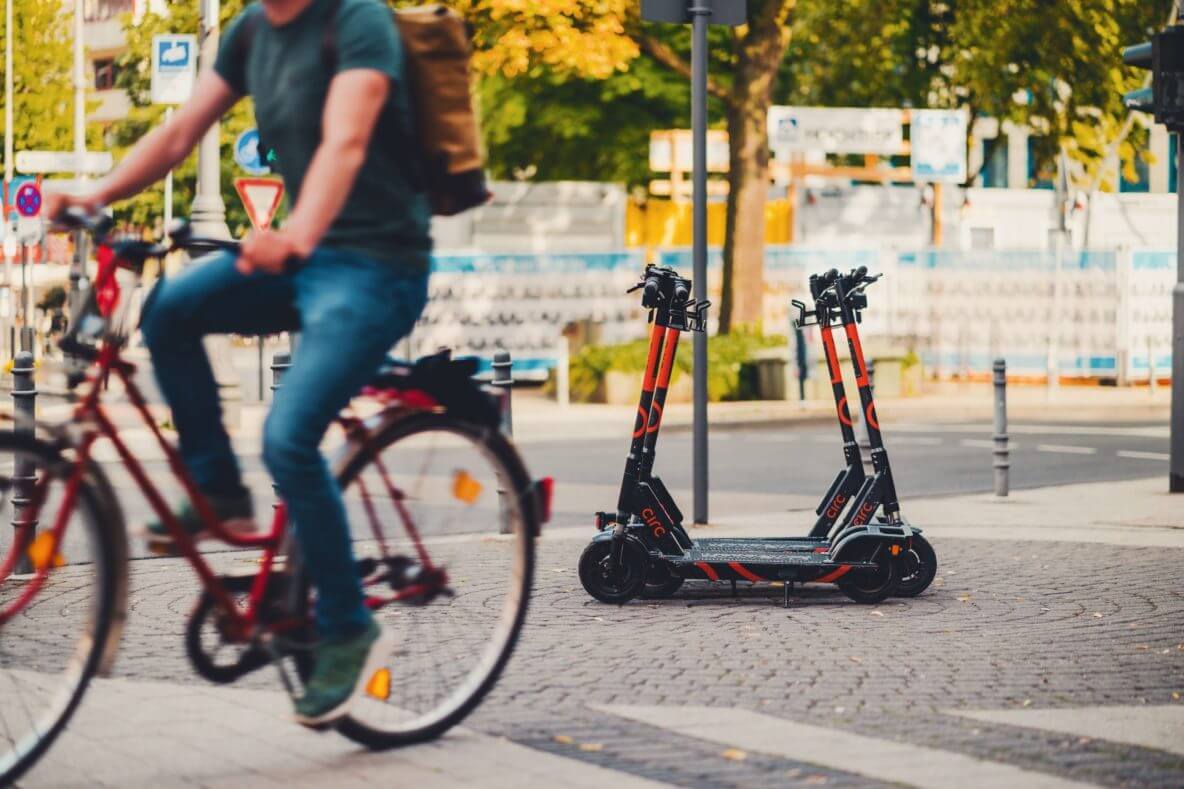
Inhaltsverzeichnis
E-scooter: What are you really good for?
In the summer of 2019, they sprung up like mushrooms in Germany overnight: e-scooters. Since then, opinions have been divided: Some believe that e-scooters are sustainable and relieve traffic congestion; others, however, are annoyed and see them as more of a threat to the already congested bike paths. So, what is the true state of sustainability of e-scooters?
The basic facts
E-scooters, also known as e-kick scooters or e-stand-up scooters, have been on Germany's streets since June 15th. Indeed, they've been almost impossible to miss since then. However, Germany isn't a pioneer in this area; in fact, the scooters have been available in many European cities since the beginning of 2018.
The 20 km/h e-scooters can be ridden from the age of 14 on bike paths. Helmets are not required. E-scooters must be insured. And that's about it for the basic rules.
The arguments
If you ask around among your friends, the most common arguments in favor of using e-scooters are the following:
- It's fun!
- These things are practical; you can get anywhere quickly without having to get your bike out of the basement.
- You can start from wherever you are.
- E-scooters are a more sustainable alternative to driving a car.
- You feel free and flexible.
But there are also some arguments against e-scooters:
- They litter the streets. It's annoying that they're everywhere, and hardly anyone parks them properly.
- These things are unsafe and therefore pose a danger.
- There is not enough space on the bike paths.
- We don't even know yet whether they really represent an ecological alternative to the transport system...
But what is the truth behind these arguments?
Flexibility and freedom
There's hardly anything wrong with this argument. If you want to get from A to B quickly, you can grab an e-scooter and get to your destination in no time – at least faster than walking. The scooters aren't really expensive either: Anyone who wants to ride one pays 1 euro. Depending on the city, you'll be charged an additional 15-30 cents per minute.
Cityscape
I have to say, e-scooters sometimes annoy me, too. Scooters parked in the middle of the sidewalk or thrown into the nearest ditch—that's definitely not the point. It would certainly be good if the e-scooter system could be expanded further; if there were more designated parking spaces and the streets were better developed or optimized for riding such scooters. Perhaps it's all just a matter of getting used to it for many of us; sometimes we just have a hard time with new things and therefore initially do them poorly.
Security
Across Europe, there have unfortunately been several fatalities involving e-scooters. The fact that helmets aren't mandatory doesn't make things any safer, of course. Riding two people on an electric stand-up scooter is also dangerous. For these reasons, France recently tightened its rules for riding e-scooters. Anyone using their cell phone while riding, or riding with a partner, can now expect a €35 fine. The speed limit in France is now 25 km/h; however, e-scooters are still permitted on sidewalks (albeit with stricter rules).
In Germany, these rules are stricter from the outset (the speed limit is 20 km/h; cycling is only permitted on cycle paths), but there are also fines: €20 for obstructing other road users and €10 for riding with a passenger. You can find the complete list of fines here. here The problem here is always that the violations have to be recognized and recorded in the first place…
There are currently four major providers in Germany: Lime and BIRD from the US, voi from Sweden, circ from Luxembourg, and TIER, a Berlin-based startup. Next spring, we can expect a few more providers to join.
However, a reduction in the number of providers would be better for safety, as this would also reduce the number of e-scooters themselves.

Sustainability of e-scooters
Now let’s get to the really exciting point: What about the sustainability of e-scooters?
First of all, e-scooters are electric and lighter and smaller than cars. This means they also produce less CO2. However, the ultimate impact is still unclear, as there are no official studies on the subject.
Initial assessments and comparisons with e-bikes show that an e-scooter produces around 5 g of CO2 when charging its battery to travel 1 km. A car burns around 120 g of CO2 for the same distance. The sheer numbers therefore favor the e-scooter. But is that enough to call it sustainable?
For now, the scooters simply mean more vehicles on the streets. It's questionable whether e-scooters will truly replace car journeys. It seems as though pedestrians, in particular, are using the scooters to cover longer distances. Thus, they don't complement public transport, but rather hinder it. Instead of taking the bus or train, some are now riding e-scooters. And I doubt whether that's truly sustainable.
For e-scooters to truly contribute to greater sustainability and a better climate balance in the future, three things would have to change:
1. Usage behavior:
E-scooters are intended to replace car traffic. They are ideal for the "last mile," for example, from home to the bus or train. In addition, electric stand-up scooters are only available in large cities where public transport is already well-developed. They are not available in rural areas, even though they would be good alternatives to cars precisely there. The reason scooters are not available in rural areas is that the business only becomes profitable for providers with populations of around 100,000 or more.
2. The battery:
The batteries in the scooters are permanently installed. Therefore, the e-scooters must be collected and charged by employees in the evening. They are often collected by diesel or gasoline-powered vans, which really doesn't help the ecological balance. Some providers are now working on e-scooters that will be equipped with replaceable batteries, meaning they no longer need to be moved. E-cargo bikes will then have their batteries swapped on-site. This would significantly improve the situation.
3. Longevity:
E-scooters need to last longer to achieve a better carbon footprint. Currently, according to the manufacturer, they last about a year. Unfortunately, many people don't treat e-scooters as carefully as they would their own personal scooter.This is how the scooters end up in the port in Marseille, somewhere in nature in Greece, and in Paris, incorrectly parked e-scooters are disposed of as bulky waste…
After all, the e-scooters are designed in such a way that individual parts can be replaced, which can sometimes significantly increase their service life.
So we can conclude that e-scooters aren't really doing anything for the climate at the moment. While they are inherently more climate-friendly than cars, for that to really count, they have to replace car journeys. It's not yet clear whether this is just a hype that generates a lot of e-waste or a truly profitable market. Time will tell.
What do you think about e-scooters and their sustainability?
If you would like to learn more about sustainability, mindfulness or healthy eating, take a look here over.




























Leave a comment
This site is protected by hCaptcha and the hCaptcha Privacy Policy and Terms of Service apply.